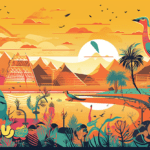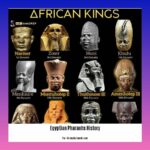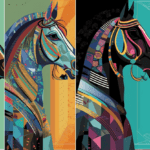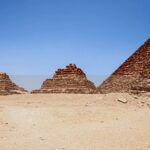Are you ready to embark on a mesmerizing journey through the mystical realms of ancient Egypt? Brace yourself, for we are about to unravel the secrets of Egypt’s famous myths and legends that have captivated the hearts and minds of mortals throughout the ages. Prepare to be transported to a world where majestic pharaohs walked among gods, and where larger-than-life creatures roamed the banks of the Nile. Join me as we delve deep into the mythical tapestry of Egypt’s ancient wonders, exploring the rich layers of stories and symbolism that have shaped the cultural fabric of this remarkable civilization. Are you ready to embark on an unforgettable adventure? Let us embark on this quest together, unraveling the enigmatic tales that continue to mystify and inspire us to this very day.
Famous Egyptian Myths And Legends
Welcome to a mystical journey through the captivating world of Egyptian myths and legends. Prepare to be transported to a mythical realm filled with gods, pharaohs, and larger-than-life creatures. In this article, we will delve into some of the most famous Egyptian myths, exploring their significance and uncovering the cultural fabric of ancient Egypt. So, grab a seat and let’s dive into the wonders of Egypt’s famous myths and legends.
The Creation Myth of Ra: Unveiling the Origins
One of the most famous Egyptian myths is the Creation Myth of Ra, also known as the Myth of Creation. Imagine a time when all was darkness, and nothing existed. It is within this vast emptiness that Ra, the sun god, emerged from an egg. As the sun rose, Ra named all living beings, including mankind. This compelling myth symbolizes the birth of life and illuminates the importance of the sun in Egyptian culture.
“Through the Creation Myth of Ra, we witness the extraordinary power of the sun god, Ra, and the origins of life itself.”
The Myth of Osiris and Isis: Betrayal and Resurrection
Another renowned Egyptian myth is the myth of Osiris and Isis. This tale centers around Osiris, the god of the afterlife, and his sister-wife Isis. Osiris was betrayed and murdered by his jealous brother Set, who sought to claim the throne of Egypt for himself. Isis, with her unwavering love for Osiris, managed to resurrect him temporarily, leading to the conception of their son Horus. This myth explores themes of betrayal, love, and the eternal cycle of life and death.
“In the myth of Osiris and Isis, we find a tragic story of betrayal interwoven with love and the hope for rebirth.”
The Myth of Horus and Set: A Clash of Titans
The myth of Horus and Set tells the story of the epic struggle between Horus, the rightful heir to the throne of Egypt, and Set, the treacherous brother of Osiris. Set, driven by his thirst for power, seeks to overthrow Horus and claim the throne for himself. The myth chronicles their intense battles, with Horus eventually emerging victorious and restoring balance to the kingdom. This myth symbolizes the eternal battle between good and evil, and the triumph of justice over tyranny.
“Through the myth of Horus and Set, we witness the relentless determination of Horus and the eternal struggle between light and darkness.”
Anubis and the Weighing of the Heart: The Journey to the Afterlife
In the myth of Anubis and the Weighing of the Heart, we explore the concept of judgment after death. Anubis, the jackal-headed god, presides over the weighing of the heart ceremony. In this ritual, the heart of the deceased is weighed against the feather of Ma’at, the goddess of truth and justice. If the heart is lighter than the feather, the soul is granted eternal life. However, if the heart is heavy with sin, it is devoured by a fearsome creature, leading to eternal damnation.
“The myth of Anubis and the Weighing of the Heart underscores the ancient Egyptian belief in the importance of leading a just and righteous life.”
Cats and Bastet: An Endearing Relationship
Cats hold a special place in ancient Egyptian culture, often associated with the goddess Bastet. Bastet, depicted as a lioness or a woman with the head of a lioness or domestic cat, represents fertility, protection, and love. Ancient Egyptians revered cats for their ability to safeguard homes and rid them of pests. Bastet’s influence is evident in the significance of cats in Egyptian mythology, making them one of the most beloved creatures in the ancient world.
“Cats, adored as symbols of protection and love, played an integral role in ancient Egyptian mythology, with the goddess Bastet watching over them.”
Mythology’s Influence on Egyptian Culture and Religion
Egyptian myths were more than mere stories; they formed the foundation of ancient Egyptian culture and religion. These myths were often conveyed through epic poems and recorded on delicate papyri. Egyptians believed in the divine stories as a way to explain natural phenomena, understand the complexities of life, and connect with the gods. The myths also guided religious practices, rituals, and the role of pharaohs in society.
“Egyptian mythology’s influence on ancient Egyptian culture and religion was immense, shaping their beliefs, rituals, and societal structure.”
As we conclude our journey through Egypt’s famous myths and legends, we have witnessed the enigmatic tales of creation, betrayal, resurrection, and judgment. Each myth offers a glimpse into the intricate cultural fabric of ancient Egypt, allowing us to appreciate their rich mythology. So next time you gaze at the sunset or hear the purr of a cat, remember the fascinating stories that shaped the ancient world of Egypt.
[Table Placeholder]
In ancient Egypt, there are numerous fascinating myths that have captured the imaginations of people for centuries. From tales of powerful gods and goddesses to stories of epic quests and enchanting creatures, the famous Egyptian myths are a treasure trove of adventure and wonder. If you’re interested in exploring these captivating tales, look no further. Click here to delve into the realm of famous Egyptian myths and embark on an incredible journey through the ancient civilization: famous egyptian myths.
murdered by his jealous brother Seth, leading to a power struggle for the throne of Egypt. Isis, Osiris’ wife and sister, manages to resurrect him and their son Horus seeks revenge against Seth, eventually becoming the rightful ruler of Egypt. – Anubis and the Afterlife: Anubis, the jackal-headed god, is associated with death and mummification. He guides souls to the afterlife and judges their hearts to determine their fate. – Bastet, the Cat Goddess: Bastet is a protective goddess associated with the sun. Cats were considered sacred animals in ancient Egypt and were worshipped for their ability to ward off evil. Bastet was also associated with Sekhmet, the lion goddess.
[youtube v=”uZe49S1Q8b8″]
In Egyptian mythology, the creation myth of Ra tells the story of how the world came into existence. According to the myth, in the beginning, there was nothing but a great chaotic ocean. From this primal chaos emerged a sacred benben stone, atop which a lotus flower blossomed. This lotus flower brought forth the god Ra, who is often depicted as a being with a man’s body and the head of a falcon. With his arrival, light came into the world.
Ra, being the creator god, gave birth to the first generations of gods. Among them were Shu, the god of air, and Tefnut, the goddess of rain. The universe was enveloped by vast primordial waters, and Shu and Tefnut plunged into these waters to explore its immensity. Meanwhile, Ra became afflicted when he noticed that his children were taking a long time to return. Fearing that he may never see them again, he sent out his best messenger to find them.
Fortunately, Shu and Tefnut returned safe and sound. Ra was overjoyed, and his tears of joy were so immense that human beings were born from them. These children, born from Ra’s tears, later gave rise to Geb, the god of the earth, and Nut, the goddess of the sky. Thus, the sky and the earth were created.
The great god Ra then became the sovereign ruler of the universe and was awarded the title of the first Pharaoh. As a gift to Egypt, Ra bestowed several sacred animals, including the ox and the lion. However, his greatest offering to Egypt was the creation of the Nile River. Around its shores, a civilization flourished, dedicated to glorifying the gods.
Nevertheless, Ra had a premonition that his grandchildren would give birth to a new generation of gods who would put an end to his reign. In an effort to prevent this, Ra forbade the sky goddess Nut and the earth god Geb from having any offspring. However, Nut and Geb defied Ra and gave birth to five powerful offspring: Isis, Nephthys, Seth, Osiris, and Horus.
Upon the dethronement of Ra, Osiris, one of the most important gods in Egyptian mythology, became the new ruler of the universe. Osiris, the husband and brother of Isis, brought great prosperity and knowledge to the world. He taught mankind about agriculture, weaving, and breadmaking. Under his reign, he decreed the use of laws to bring order to the chaos that previously existed.
However, Osiris had a powerful and ambitious brother named Seth. Seth, who ruled over the arid deserts surrounding Egypt, was envious of his brother’s fertile and prosperous kingdom. Seth plotted against Osiris and had an affair with his wife, Nephthys, which resulted in the birth of the god Anubis. Fueled by betrayal and jealousy, Seth orchestrated a grand feast where he trapped and murdered Osiris.
This act of treachery plunged Isis into profound grief, and her tears poured into the Nile River, giving rise to its traditional floods. With the help of her sister, Nephthys, Isis set out to find the body of Osiris. She managed to recover the scattered pieces and used her divine powers to mummify his body. Through a ritual guided by Anubis, Osiris was resurrected, but he would now reign over the world of the dead.
From the union of Isis and Osiris, their son Horus was born. Horus was deemed the rightful heir to the throne that Seth had usurped. The ongoing struggle between Horus and Seth led to a series of battles and challenges. In one instance, Seth plucked out Horus’ eyes, but they were restored by the goddess Hathor. The gods eventually intervened, and after many years of conflict, Horus emerged victorious.
Horus’ reign as the ruler of Egypt brought about a period of peace and prosperity. He is often depicted as a falcon-headed god, symbolizing his connection to the skies and his role in bringing light back to Egypt. The Pharaohs who ruled Egypt were believed to be descendants of Horus, cementing his reign as a central figure in Egyptian mythology.
Ra, the sun god, holds a significant place in Egyptian mythology. As the bringer of light and the one who drives away darkness, Ra was deeply revered throughout Egypt. He embarked on a daily journey across the sky in his sun boat, bringing light and warmth to the world. However, during the twilight hours, Ra would descend into the underworld, navigating through its dark regions.
Throughout his journey in the underworld, Ra faced numerous challenges. One of the most daunting obstacles was the serpent Apophis, a force of chaos that sought to destroy Ra’s sun boat. The serpent constantly threatened to engulf the sun, plunging the world into eternal darkness. However, Ra’s journey became safer when the god Seth, who had been condemned to travel with Ra, aided in defending the sun boat against Apophis.
Ra’s worship was particularly prominent in the city of Heliopolis, where his prestige influenced other Egyptian religions. For instance, the supreme gods Amun and Atum merged with Ra, giving rise to figures like Amun-Ra and Atum-Ra. The name of Ra was also incorporated into the titles of many pharaohs, signifying their divine connection and power.
Anubis, with his jackal head, is an important deity associated with death and the afterlife in Egyptian mythology. He played a crucial role in guiding souls to the underworld and judging their hearts during the judgment of the dead. Anubis was also the god of embalming and mummification, often depicted as a part-human, part-animal figure overseeing funeral rituals.
Anubis is the son of the goddess Nephthys and, as the story goes, was not born from her union with her husband Seth. Instead, Nephthys disguised herself as the goddess Isis and mingled with Osiris, resulting in the birth of Anubis. Anubis played a significant role in the burial customs of ancient Egypt, transforming the body of Osiris into the first mummy and ensuring that the deceased had a proper passage to the afterlife.
During the Greek and Roman periods, Anubis became associated with Hermes, the Greek deity who fulfilled a similar role of guiding souls to the underworld. This association led to the creation of a deity called Hermanubis, which gained popularity during the Roman rule over Egypt. Anubis continues to be one of the most revered and popular gods in Egyptian mythology.
Bastet, the cat goddess, holds a special place in Egyptian mythology, particularly due to the Egyptians’ reverence for cats. Cats were considered sacred animals and were cherished for their ability to protect households from rodents and dangerous snakes. Bastet is depicted as having a woman’s body with a cat’s head, representing her connection to feline qualities.
Associated with the sun, Bastet would accompany Ra during the day in his solar boat as he traversed the skies. At night, she would transform into a lioness, guarding the world against the serpent Apophis. Harm to a cat was seen as a sacrilege, and anyone who committed such an act could face severe punishment, even death.
Cats were believed to have a divine connection, as some legends suggest that they would enter burning houses to help their human companions escape. The cats were said to have the ability to survive the flames and be resurrected by Bastet herself. The concept of cats having nine lives emerged from these beliefs, solidifying their sacred status.
The goddess Bastet is sometimes associated with Sekhmet, the lion goddess. In some versions, Bastet and Sekhmet are depicted as sisters and daughters of Ra. Their roles and characteristics complement each other, as Sekhmet represents fierceness and aggression while Bastet embodies gentleness and protection. These aspects of their mythologies continue to fascinate and capture the imagination.
FAQ
Question: What are some famous Egyptian myths and legends?
Answer: Some of the most famous Egyptian myths include the creation myth of Ra, the myth of Osiris and Isis, the myth of Horus and Set, and the myth of Anubis and the Weighing of the Heart.
Question: What is the Myth of Creation in Egyptian mythology?
Answer: The Myth of Creation, also known as the Story of Re, is about an egg that named all living beings, including mankind.
Question: Can you tell me about the Battle of Set and Horus in Egyptian mythology?
Answer: The Battle of Set and Horus is a myth about the struggle between Horus and Set for the throne of Egypt.
Question: What is the myth of Anubis and the Weighing of the Heart?
Answer: The myth of Anubis and the Weighing of the Heart explores the concept of judgment after death.
Question: Are cats and Bastet associated with Egyptian mythology?
Answer: Yes, cats and Bastet, the goddess of protection, are closely associated with Egyptian mythology and were highly revered in ancient Egyptian culture.
- Unraveling Einstein’s Legacy: Who Inherited His Genius? - July 14, 2025
- Unlock Einstein’s Family Tree: Bernhard Caesar & Untold Stories - July 14, 2025
- Unveiling Bernhard Caesar Einstein: His Life & Albert Einstein’s Legacy - July 14, 2025
















